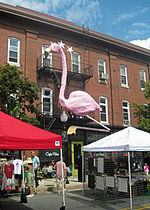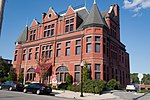The Space Telescope Science Institute (STScI) is the science operations center for the Hubble Space Telescope (HST), science operations and mission operations center for the James Webb Space Telescope (JWST), and science operations center for the Nancy Grace Roman Space Telescope. STScI was established in 1981 as a community-based science center that is operated for NASA by the Association of Universities for Research in Astronomy (AURA). STScI's offices are located on the Johns Hopkins University Homewood Campus and in the Rotunda building in Baltimore, Maryland.In addition to performing continuing science operations of HST and preparing for scientific exploration with JWST and Roman, STScI manages and operates the Mikulski Archive for Space Telescopes (MAST), which holds data from numerous active and legacy missions, including HST, JWST, Kepler, TESS, Gaia, and Pan-STARRS.Most of the funding for STScI activities comes from contracts with NASA's Goddard Space Flight Center but there are smaller activities funded by NASA's Ames Research Center, NASA's Jet Propulsion Laboratory, and the European Space Agency (ESA).The staff at STScI consists of scientists (mostly astronomers and astrophysicists), spacecraft engineers, software engineers, data management personnel, education and public outreach experts, and administrative and business support personnel. There are approximately 200 Ph.D. scientists working at STScI, 15 of whom are ESA staff who are on assignment to the HST and JWST project. The total STScI staff consists of about 850 people as of 2021.STScI operates its missions on behalf of NASA, the worldwide astronomy community, and to the benefit of the public. The science operations activities directly serve the astronomy community, primarily in the form of HST and JWST (and eventually Roman) observations and grants, but also include distributing data from other NASA and ground-based missions via MAST. The ground system development activities create and maintain the software systems that are needed to provide these services to the astronomy community. STScI's public outreach activities provide a wide range of resources for media, informal education venues such as planetariums and science museums, and the general public. STScI also serves as a source of guidance to NASA on a range of optical and UV space astrophysics issues.
The STScI staff interacts and communicates with the professional astronomy community through a number of channels, including participation at the bi-annual meetings of the American Astronomical Society, publication of regular STScI newsletters and the STScI website, hosting user committees and science working groups, and holding several scientific and technical symposia and workshops each year. These activities enable STScI to disseminate information to the telescope user community as well as enabling the STScI staff to maximize the scientific productivity of the facilities they operate by responding to the needs of the community and of NASA.






